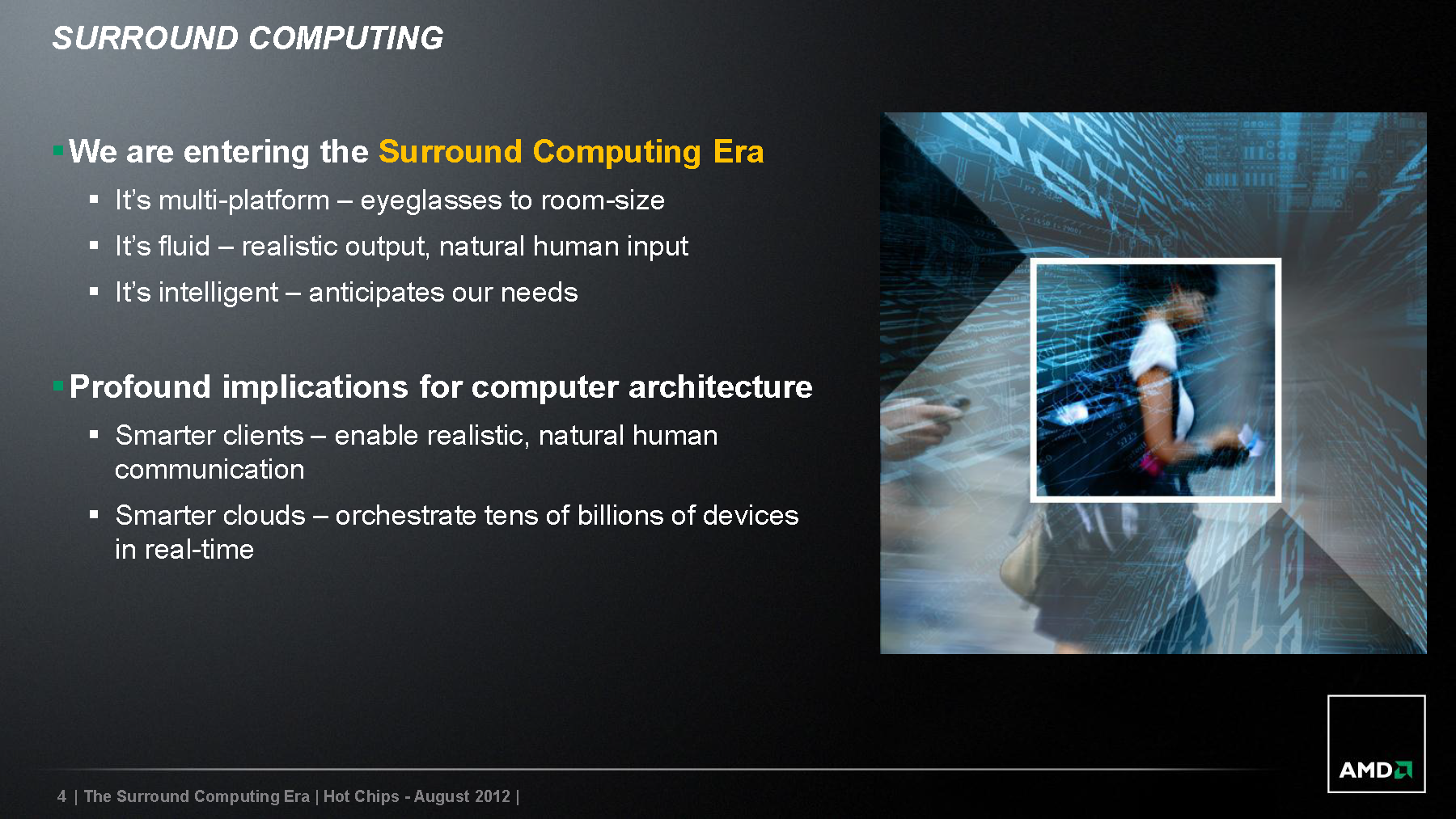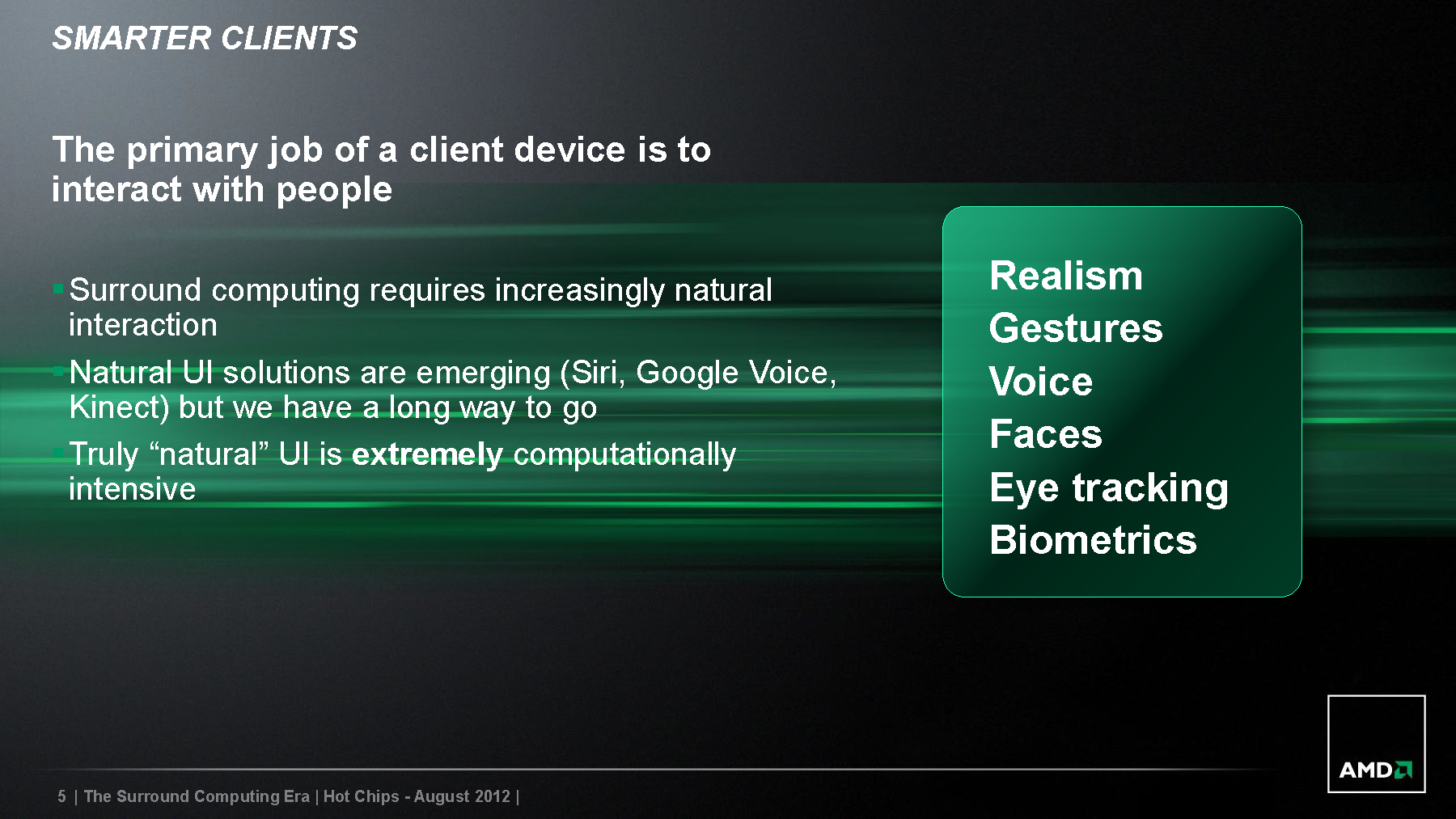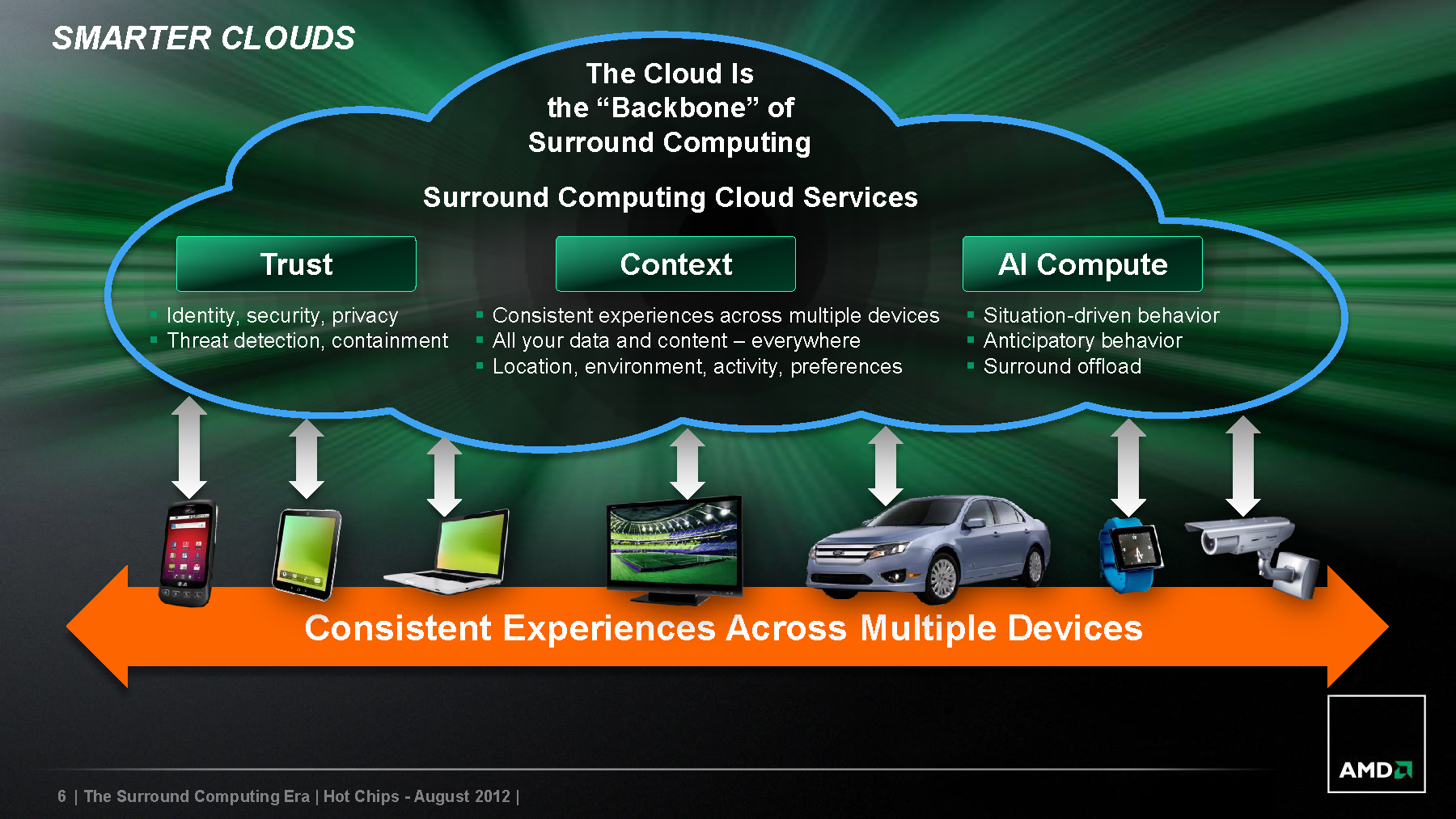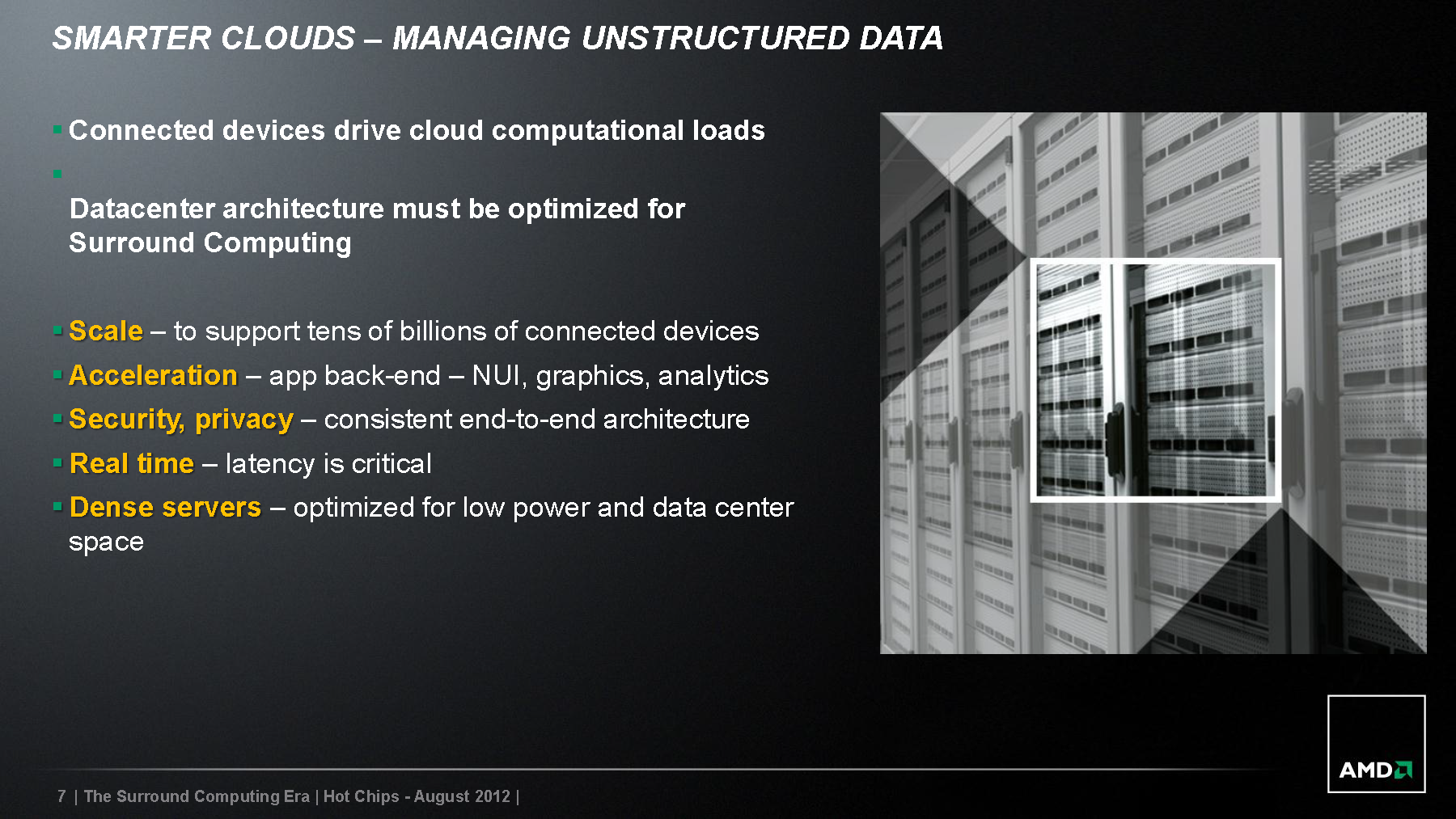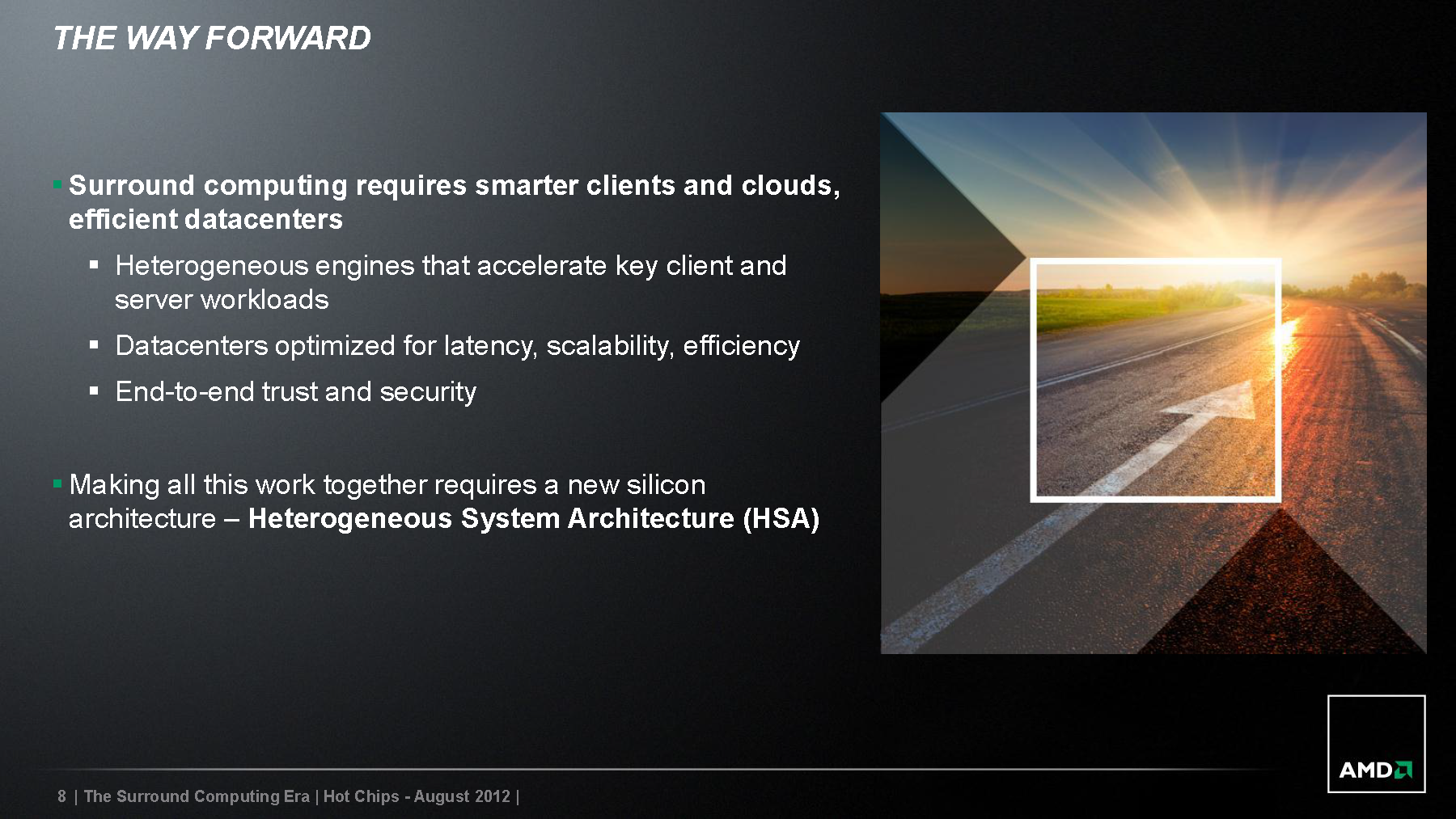AMD's Vision of the Future is All About ''Surround Computing''
At today's Hot Chips Symposium, Mark Papermaster, Senior Vice President and CTO of AMD, talks about the future of "Surround Computing".
AMD shared with us that it has spent the last 10-20 years developing processors that could simulate "visual reality," and it's going to spend the next couple of decades turning that 'visual computing era' on its head and develop processors and platforms that start with an image (or series of images, or GPS data, or other environmental data), interpret their contents and context, and use that to deliver better real time experiences to users. Thie company told us that this will leverage both cloud and client based processing, tying together all of the technologies and architectures that AMD has to offer.
Looking at the vision of what Surround Computing is and what is might look like in not-too-distant future, AMD offered up this example:
"Imagine it’s noon and you’re heading out of the office for lunch. As you leave, your mobile device intuitively knows where you’re going by automatically calculating multiple data points streaming in from the built-in GPS, clock, maps and cloud database connection. Since it knows your preferences so well, it goes to your favorite restaurant’s website and checks the specials. A friendly automated voice inside your device springs to life and offers to take your lunch order. You reply, 'lunch salad to go,' and the device places the order for you. By the time you arrive at the restaurant, it’s ready for pickup. An electronic payment was completed while you were in transit, so you don’t even have to reach for your wallet. And all of this happens without downloading apps or typing on your phone."
It may sound like something out of the Jetsons, but keep in mind that this is AMD's visions for decades from now. No back to your regularly scheduled discussion on Surround Computing.
“Surround computing imagines a world without keyboards or mice, where natural user interfaces based on voice and facial recognition redefine the PC experience, and where the cloud and clients collaborate to synthesize exabytes of image and natural language data. The ultimate goal is devices that deliver intelligent, relevant, contextual insight and value that improves consumers’ everyday life in real time through a variety of futuristic applications. AMD is leading the quest for devices that understand and anticipate users’ needs, are driven by natural user interfaces, and that disappear seamlessly into the background,” said Papermaster during his opening remarks.
Papermaster explained that the Surround Computing Era will rely on "robust plug-and-play IP portfolios" including CPUs, GPUs, fixed function logic, and interconnect fabric. He also unveiled key details of AMD's upcoming "Steamroller" CPU architecture while underscoring the benefits of the industry-standard Heterogeneous Systems Architecture (HSA) that enables software developers to easily assign scalar and parallel compute workloads to the most appropriate compute units, and therefore optimize power.
"The road that leads us to the Surround Computing Era will be no less challenging and every bit as exciting as the 20-year journey in graphics processing that brought gamers from ‘Pong’ to today’s modern game titles that feature stunning visual realism,” Papermaster explained. “It will take an industry movement to complete this journey, and HSA provides the clear path forward to enable this next generation in computing."
Get Tom's Hardware's best news and in-depth reviews, straight to your inbox.
Read more details from AMD during Hot Chips Symposium on its High Density (Thin) Libraries and Steamroller.
-
A Bad Day For those who want to accuse AMD of being on LSD, it's at least better to have a seemly-impossible future vision, than to expect the future to be the present.Reply
Back in the 1970's, one of Xerox's research teams built a modern-day desktop computer. It had colored GUI, network connection, and other stuff that other computers in the early-mid 1980's didn't have.
The management told the research team that developing computers has no future, and Xerox should only focus on printers. -
ekho If I'm not wrong, Intel kinda stole the idea of FUTURE IS FUSION.Reply
AMD has good ideas but they need more potential power. They need perhaps their own Fabs to do great works independently. They need like thousands of engineers not only in case of hardware but way into the software engineers too.
Most of all, they got idea...good but please hurry AMD! -
teh_chem Historical appreciation for AMD aside, QUEUE THE RHETORIC!!!Reply
Personally, I'd like to see mass-adoption of the architectural improvements that the modular "fusion" architecture is capable of. Get rid of the crappy, old, archaic, and stale compiling that's been used for the last 2+ decades and make way for something revolutionary. AMD's already working on internal R&D to make this more-widescale, but until that happens...QUEUE THE RHETORIC!!! ;) -
azraa ekhoIf I'm not wrong, Intel kinda stole the idea of FUTURE IS FUSION.AMD has good ideas but they need more potential power. They need perhaps their own Fabs to do great works independently. They need like thousands of engineers not only in case of hardware but way into the software engineers too.Most of all, they got idea...good but please hurry AMD!Reply
I agree, but you have to remember that AMD's market share, and total income is minuscule compared to the one of other electronics companies, like Intel or Samsung.
Their research budget is probably larger than many, in a relative scale
Yet they are able to drive this progress, from the shadowy corners of a world consumed by advertising.
That is something to applaud. -
IndignantSkeptic What I don't understand in their vision of the future is why there is an office.Reply -
DRosencraft Visions should always be a little outlandish. Dreams of the future too buried in realism tend to be so dull that anyone can do them, and your company itself gets bored of the pursuit. Challenge your design teams to reach for something that is both plausible and difficult, and then empower them to pursue it. That's how the U.S reached the moon, and how many great companies changed the world.Reply -
darkavenger123 ekhoIf I'm not wrong, Intel kinda stole the idea of FUTURE IS FUSION.AMD has good ideas but they need more potential power. They need perhaps their own Fabs to do great works independently. They need like thousands of engineers not only in case of hardware but way into the software engineers too.Most of all, they got idea...good but please hurry AMD!Reply
Err...AMD have their own fabs...in fact, they have too much resources and nothing to produce until they're forced to separate the fab entity to become Global Foundaries.
-
darkavenger123 AMD damage control...it means "We can't compete with Intel now. Wait another 20 years and we'll make a comeback!".Reply
